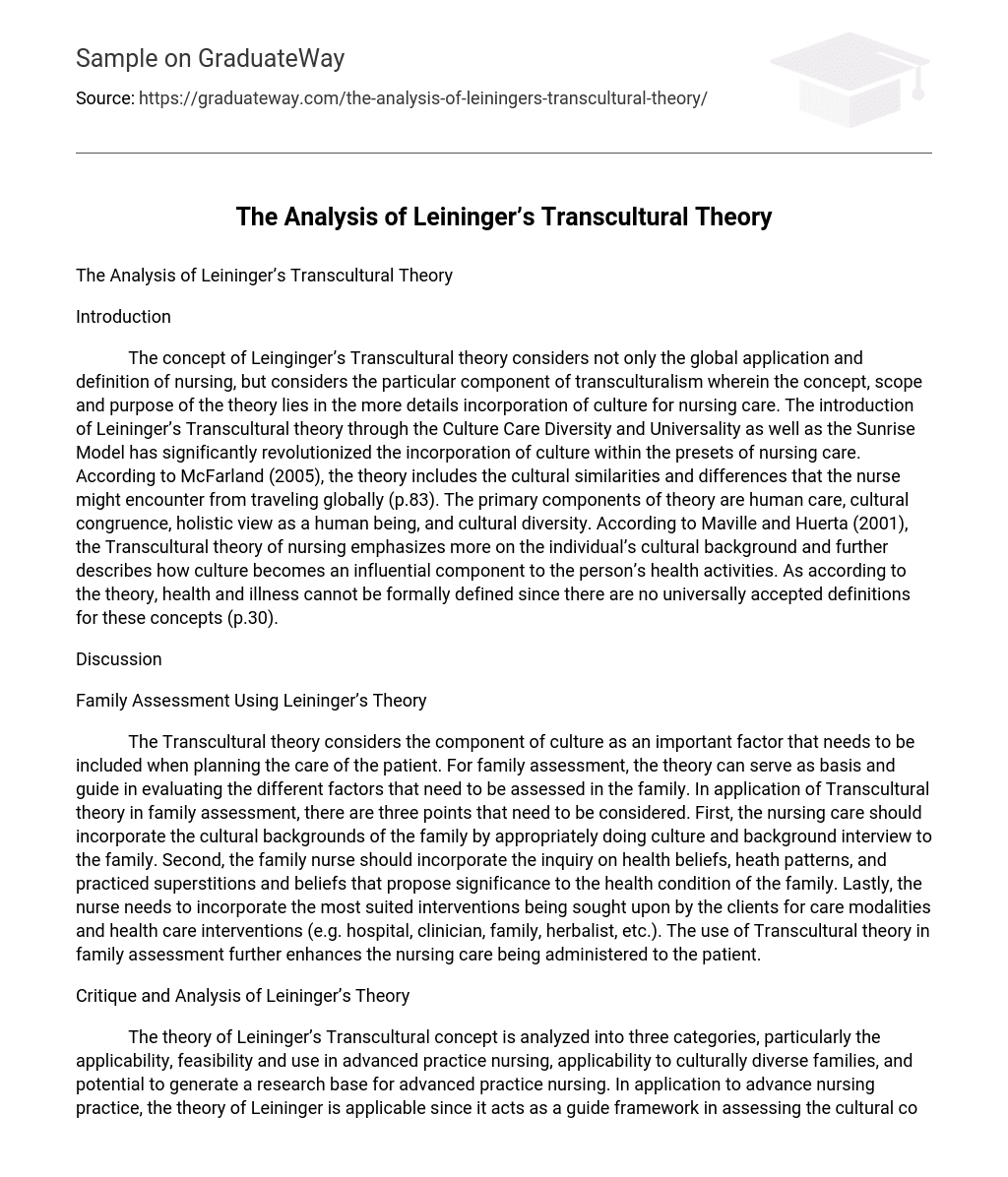Introduction
The concept of Leinginger’s Transcultural theory considers not only the global application and definition of nursing, but considers the particular component of transculturalism wherein the concept, scope and purpose of the theory lies in the more details incorporation of culture for nursing care. The introduction of Leininger’s Transcultural theory through the Culture Care Diversity and Universality as well as the Sunrise Model has significantly revolutionized the incorporation of culture within the presets of nursing care. According to McFarland (2005), the theory includes the cultural similarities and differences that the nurse might encounter from traveling globally (p.83). The primary components of theory are human care, cultural congruence, holistic view as a human being, and cultural diversity. According to Maville and Huerta (2001), the Transcultural theory of nursing emphasizes more on the individual’s cultural background and further describes how culture becomes an influential component to the person’s health activities. As according to the theory, health and illness cannot be formally defined since there are no universally accepted definitions for these concepts (p.30).
Discussion
Family Assessment Using Leininger’s Theory
The Transcultural theory considers the component of culture as an important factor that needs to be included when planning the care of the patient. For family assessment, the theory can serve as basis and guide in evaluating the different factors that need to be assessed in the family. In application of Transcultural theory in family assessment, there are three points that need to be considered. First, the nursing care should incorporate the cultural backgrounds of the family by appropriately doing culture and background interview to the family. Second, the family nurse should incorporate the inquiry on health beliefs, heath patterns, and practiced superstitions and beliefs that propose significance to the health condition of the family. Lastly, the nurse needs to incorporate the most suited interventions being sought upon by the clients for care modalities and health care interventions (e.g. hospital, clinician, family, herbalist, etc.). The use of Transcultural theory in family assessment further enhances the nursing care being administered to the patient.
Critique and Analysis of Leininger’s Theory
The theory of Leininger’s Transcultural concept is analyzed into three categories, particularly the applicability, feasibility and use in advanced practice nursing, applicability to culturally diverse families, and potential to generate a research base for advanced practice nursing. In application to advance nursing practice, the theory of Leininger is applicable since it acts as a guide framework in assessing the cultural components of the patient that need to be included in the planning of care. In terms of feasibility, the theory emphasizes the components, culture, diversity and human beings as holistic individuals, and does not coincide in specific culture but rather considers an international cultural perspective. The theory considers a general view of culture and the application of nursing care according to any form of culture it encounters; hence, despite of vast cultural diversions, a nurse should still be able to deliver appropriate and standardized nursing care, which makes the theory applicable to culturally diverse families. Lastly, the difference of culture and the difference of nursing care being applied accordingly provides newly discovered nursing intervention as per encounter as the nurse encounters different care measures from culturally diverse patients. The principles of the theory in considering the culture and the holistic characteristics of human beings signifies the need for vast culturally appropriate nursing interventions that best suit the vast cultural needs of the patient; hence, becoming a potential generator of new culturally appropriate interventions.
Reference
Maville, J. A., & Huerta, C. G. (2001). Health Promotion in Nursing. Thomson Delmar Learning.
McFarland, M. R. (2005). Culture Care Diversity and Universality: A Worldwide Nursing Theory. Jones & Bartlett Publisher.





